Boncilla
In 1900, John M. Price moved to Indianapolis to take up a position with the Crown Chemical Company, a business best known for its White Line Washing Powder. Price’s mother, Lydia Alice Garriott Price [1852-1909] was related to Augustus Francis Garriott [1886-1912], who had founded Crown Chemical in 1896, so I assume John Price’s decisions to move from Scottsburg, Indiana, where he worked in the hardware business, was a family decision. When Crown Chemical incorporated in 1902 (capital US$75,000), John Price was the company’s secretary/ treasurer but he became its president in 1905 when Augustus Garriott retired.
Early washing powders were made with soaps manufactured from fats and oils rather than synthetic detergents used today. Supplies of fats and oils became short during the First World War and this may have been the reason why Price decided to add cosmetics to Crown Chemical’s product range.
The first cosmetic introduced by Crown Chemical appears to have been a facial clay that would become known as the Boncilla Beautifier. There is some evidence to suggest that it was originally developed for men in barber shops but was later taken up by beauty parlours as well as drug and department stores.
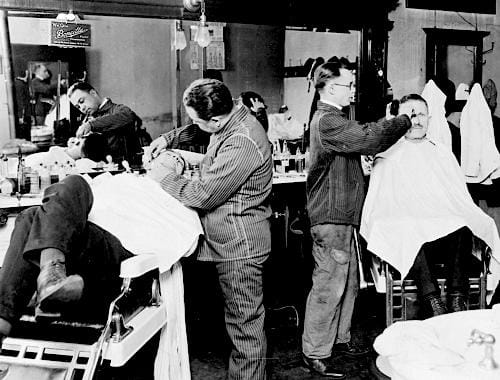
Above: 1923 Barber shop in Dayton, Ohio. Note the ‘We give Boncilla Facial Treatments’ sign in the top left corner.
In 1920, Crown Chemical decided to concentrate solely on cosmetics and sold its washing powder and other grocery interests manufactured at 311-313 East South Street to Callane & Sons, moving its cosmetic business into a new factory at 439-441 East South Street. In 1922, it moved again to 134-140 Pennsylvania Street and changed its company name to Boncilla Laboratories, Inc.
Boncilla would remain at 134-140 Pennsylvania Street for many years with in what became known as the Boncilla Building. The top/fourth floor was used primarily for storage of raw materials. Boncilla creams, powders and perfumes were manufactured on the third floor with the creams sent down through steam-heated tubes to automatic filling machines on the second floor. These joined other Boncilla products that were packed and shelved there ready for delivery. The shipping department occupied the rear of the ground/first floor with the front half, facing Pennsylvania Street, made up of offices.
Boncilla occupied two other sites in Indianapolis. One was used for storage, the other, at 311 East South Street, housed the Crown Box Company which made all the powder boxes, display cartons and shipping containers used by Boncilla. Jars and tubes used by the company appear to have come from other suppliers.
By the time Crystal Chemical became Boncilla, exports were also adding to the company’s sales figures. Boncilla cosmetics were being sold through a depot at 29-31 Adelaide Street West, Toronto, Canada by 1920, and overseas expansion meant that the Boncilla range was available around the world by 1925.
Products
Boncilla Beautifier, the blue-grey facial clay introduced by Crystal Laboratories in 1916, was joined by Boncilla Face Powder (1916), Boncilla Cold Cream (1917), and Boncilla Vanishing Cream (1917). From 1922, the Boncilla Beautifier was generally referred to as the Boncilla Clasmic Beautifier or the Boncilla Clasmic Pack, a change presumably made to emphasise the fact that Boncilla Beautifier was a facial clay. By then, America was in the middle of a facial clay fad and Boncilla was now competing with a wide range of other facial clays, most notably Mineralava.
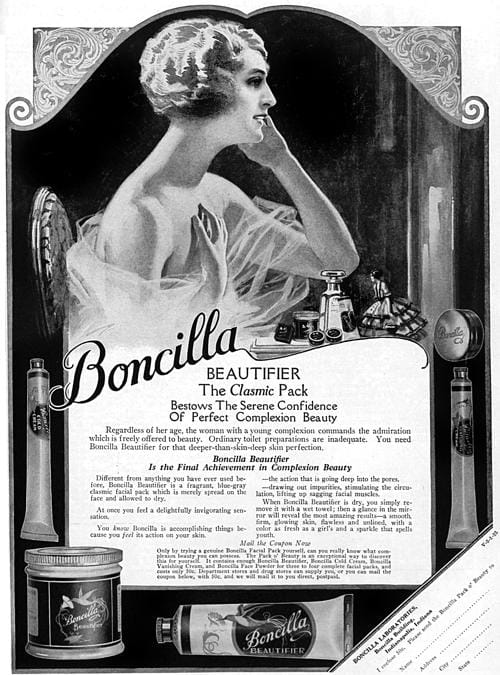
Above: 1923 Boncilla Clasmic Pack.
See also: Complexion Clays and the A.M.A.
Boncilla Clasmic Beautifier: “[C]ompounded with rare balsams and tinctures from the far corners of the earth. When it is applied to the skin it gently withdraws accumulations and impurities from the pores. Firms the muscles and restores the youthful contour of the face.”
Boncilla Cold Cream: “[P]repared to give the skin a deeper cleansing. Its emollient effects delight every user. Its use improves the texture of the skin and keeps it soft and velvety. … [E]specially recommended for dry skins.”
Boncilla Vanishing Cream: “It is greaseless and invisible, and does not dry skin. Apply it before going out to protect your skin against wind and dust, and also for the proper base for face powder.”
Boncilla Face Powder: “[C]an be used for years without fear of harming the skin. Its healing and protective qualities are unusual. Its clinging qualities will please you.” Shades: Flesh, White, Brunette, and Pink. The Pink shade was later dropped.
Boncilla combined these products together into a four-step beauty treatment routine.
Apply a warm towel to the face and thus open the pores. Smear (don’t rub) Boncilla Clasmic Beautifier over the face as soon as the towel is removed, while the pores are still open.
Cover the face thoroughly so that the skin does not show, thus making a mask over the entire face, up to the hair, around the eyes, over the nose and underneath the chin.
Allow the mask to remain on the face until it is thoroughly dry. If desired, the mask can be dried more quickly by fanning.
When thoroughly dry, remove by using real wet, tepid (not hot) turkish towel, and pressing the water from the towel into the application. It will immediately become soft and can easily be wiped off into the towel, without the slightest injury to the fabric. Then go over the face with a wet, warm towel, cleansing all the surface which has been covered.
Next apply Boncilla Cold Cream, which should be gently rubbed over the entire face, and then wiped off with soft cloth.
Boncilla Vanishing Cream is then applied. This cream closes the pores, protects the skin and forms a perfect base for the face powder.
Go over the face with a dry towel, then apply Boncilla Face Powder, which completes the Boncilla Clasmic Beautifier Treatment.
The time required for a Boncilla Clasmic Beautifier Treatment depends almost entirely on the amount of time at your disposal. The treatment can be hurried, it necessary, by the use of a fan to force quicker drying of the pack.
It is desirable, however, to relax in easy chair or on a couch while the pack dries naturally.
(‘The way to beauty,’ c.1924. pp. 40-41)
Women could buy each of these products separately but Boncilla also sold them as sets. By 1923 there were five of these: the Package-O-Beauty (Pack o’Beauty), Vanity Set, Travellers Set, Ideal Set, and Boudoir Set.
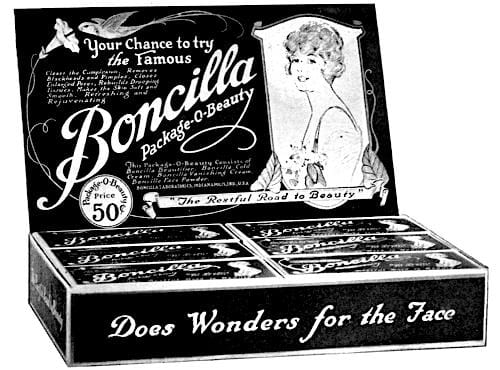
Above: 1923 Display box of Boncilla Package-O-Beauty sets.
As the market for complexion clays declined Boncilla increasingly resorted to endorsements. This reached a peak in 1927 when Boncilla published a book by the New York socialite, Mrs. Marjorie Oelrichs (née Turnbull) [1883-1952], and made it available along with a Boncilla Beauty Box.
Skin-care
Additional skin-care lines introduced by Boncilla included: Boncilla No Chafe (1918); Boncilla Healing Cream (1920), Boncilla Skin Lotion (1920), Boncilla Lemon Cream (1922), Boncilla Lemon Lotion, and Boncilla Skin Food.
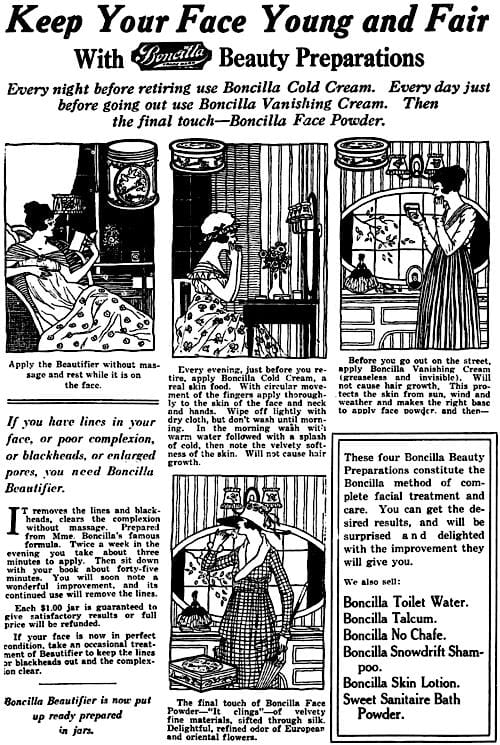
Above: 1918 Part of an advertisement for Thistlethwaite’s Cut Rate Drug Store that featured Boncilla.
Boncilla No Chafe: “Particularly essential in summer. It relieves skin irritation resulting from heat and sunburn, and to eliminate excessive perspiration.”
Boncilla Healing Cream: “No home should be without this antiseptic. It is invaluable for cuts, wounds, colds, croup, catarrh and stiff joints. A penetrating cream that gives almost instant relief.”
Boncilla Lemon Cream: “An astringent cream that keeps the skin soft and smooth, excellent for sunburn and tan, and also as a mild bleach for freckles.”
Boncilla Lemon Lotion: “Similar to Lemon Cream, except in liquid form. It penetrates readily and thoroughly. Very fine for after shaving, also in other cases where a mild astringent is desired.”
Boncilla Skin Lotion: “A pure white creamy lotion for wind-burn and chapped skins. Keeps the skin soft and smooth.”
Boncilla Skin Food: “[A] rich, nourishing cream which quickly liquifies, penetrating deeply absorbed by the cells, vitalizing them and assuring their natural healing function. Rejuvenates impoverished tissues. Hollows, wrinkles and flabbiness are thus prevented and the freshness and smoothness of the skin preserved. Apply liberally before retiring, gently into the skin—requires no massaging.”
Make-up
Boncilla added Pour le Boulevard Face Powder, Boncilla Rouge and Boncilla Lipstick in 1924 all in a limited range of shades. The Pour le Boulevard Face Powder appears to have been a type of cold cream powder of the sort sold very successfully by Armand and others. The push-up Boncilla Lip Rouge was also matched with a twist-up Pour le Boulevarde Lip Rouge. Both rouges were produced as compressed powders housed in a range of metal compacts.
See also: Armand
Eye make-up included Boncilla Cosmetique, a typical block/cake mascara and Boncilla Eyebrow Pencils. Both products only came in Brown and Black shades.
Pour le Boulevarde Face Powder: “For those who require a powder of more density. A creamy powder that stays on and blends beautifully with most any complexion. Recommended for outdoor and evening use.”
Boncilla Lip Rouge: “Pure cream pencils which keep the lips soft and give the right touch of color.” Shades: Light, Dark, and Medium with Sheik added by 1922.
Boncilla Eyebrow Pencils: “A dainty pencil to give you an ideal finishing touch.” Shades: Brown, and Black.
Boncilla Cosmetique: “[A]ssures a smartly, well-groomed effect in dainty box with brush for applying.” Shades: Brown, and Black.
Also see the booklet: Boncilla (c.1925)
Other lines
Other products in the Boncilla range included Boncilla Beauty Soap, Shampoo, Bath Crystals, Dental Cream, Talcum, and Toilette (Dusting) Powder. Boncilla also sold a perfume (Royal Bouquet) and at least two toilet waters (Royal Bouquet and Loxelle). As far as I can tell Boncilla did not sell manicure equipment or a liquid nail polish but did retail a cake powder polish.
Boncilla Nail Polish (Cake Form): “Very easy to use, and imparts a well-groomed brightness and finish to the nails.”
1930s
Like many other countries, Britain became increasingly protectionist during the Great Depression of the 1930s and increased tariffs on imports. This led Boncilla to establish Boncilla Laboratories, Ltd. at 211-215, Blackfriars Road, London in 1933 and begin local manufacturing there. The London subsidiary joined Canadian Boncilla Laboratories, Ltd. which had been founded at 590 King Street West, Toronto in 1923. The European market for Boncilla had not been strong and, as far as I can tell, Boncilla only worked through distributors there.
In 1930, Boncilla repackaged its American range in bold, modern lines. It also appears to have dropped a number of its poorer selling items, reformulated some products, and added a few new ones. The new series, known as Boncilla Mark 2 consisted of Boncilla Clasmic Pack, Cleansing Cream, Cold Cream, Cremetone, Astringent, Nourishing Cream, Foundation Cream, Face Powder, Rouge, and Lipstick.
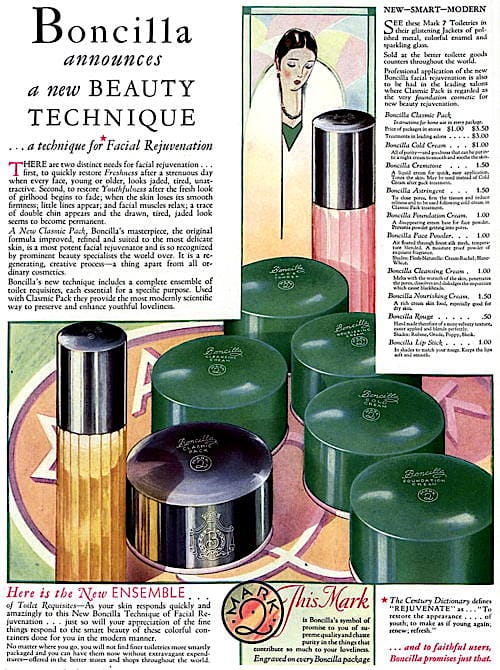
Above: 1930 Boncilla Mark 2 in packaging designed by Colin Douglas Barrett [1880-1937].
Rather than capping the bottles in conventional metal lids the Mark 2 jars were encased in complete metal shells with embossed labels. These were coloured green except for the Clasmic Pack which had a nickel finish. I’m not sure that this was a good idea as it made it difficult to distinguish the products on the shelf.
Boncilla Cold Cream: “All of purity—and goodness that can be put into a night cream to smooth and soothe the skin.”
Boncilla Foundation Cream: “A disappearing cream base for face powder. Prevents powder getting into pores.”
Boncilla Face Powder: “Air floated through finest silk mesh, temperature blended. A moisture proof powder of exquisite fragrance.” Shades: Flesh-Naturelle, Cream-Rachel, and Blanc-White.
Boncilla Cleansing Cream: “Melts with the warmth of the skin, penetrates the pores, dissolves and dislodges the impurities which cause blackheads.”
Boncilla Nourishing Cream: “A rich cream skin food, especially good for dry skin.”
Boncilla Rouge: “Hand made therefore of a more velvety texture, easier applied and blends perfectly.” Shades: Rubine, Oriole, Poppy, and Sheik.
Boncilla Lip Stick: “In shades to match your rouge. Keeps the lips soft and smooth.”
The two liquid products – Cremetone and Astringent – were bottled in glass containers with metal tops.
Boncilla Cremetone: “A liquid cream for quick, easy application. Tones the skin. May be used instead of cold cream in the Clasmic Pack treatment.”
Boncilla Astringent: “To close pores, firm the tissues and reduce oiliness and to be used following cold cream in Clasmic Pack treatment.”
Later in the year, Boncilla added the Boncilla Lemon-Magnesia Pack which included a bleach to help whiten the skin. Like the clasmic Pack it was available in jars and tubes. Boncilla recommended that Brunettes applying it twice as thick as Blondes or Titians.
Boncilla Lemon-Magnesia Pack: “Whitens skin quickly and safely. Reduces coarse pores. Draws out blemishes, blackheads, discolorałions. Gives a marvelous ‘lifting’ and youthifying effect.”
The difference between the Clasmic and the Lemon-Magnesia Packs can be seen in the table below:
| Clasmic Pack | Lemon-Magnesia Pack | |
| Cleans your skin of impurities. Reduces enlarged pores. Improves your colour. Makes the skin fairer. Eradicates many lines. Keeps the skin texture satin-mooth. | Bleaches faded sun-tan. Corrects greasy skins. Neutralises acid in the skin. Stimulates the circulation. Lightens and clears the complexion. Reduces enlarged pores. | |
In sunny countries like Australia, Boncilla recommended the Lemon-Magnesia Pack for removing any lingering traces of a sun tan at the end of summer.
Removing Sun Tan.
For removing all traces of sun-tan, which looks so out of place with evening frocks, you will need a jar of lemon magnesia pack. Before you open the jar, put ready a little bowl, a large brush, a palette knife, a towel, soap, hot water, witch hazel lotion, cold cream, and cleansing tissues.
Now place some of the fragrant lemon magnesia pack in bowl and pour over it a little witch hazel lotion. Blend the two ingredients together with the palette to form a soft white cream. Before applying the pack, wash your chest, neck and shoulders with soap and hot water, rinse well and pat dry. Then take your brush and paint the cream all over the area of sun-tan on your neck, back and chest. When the pack is quite hard and dry, moisten it so that it can be wiped away easily. Dry the skin and massage in the cold cream. Leave a layer of cold cream on the skin for a few minutes, then remove it with cleansing tissues.(Boncilla advertorial, 1933, Australia)
The Mark 2 series gets few mentions after 1930, which suggests the relaunch was a failure. Boncilla quickly returned to concentrating on promoting the Clasmic Pack with most advertising made up of small newspaper placements rather than magazines. The company also tried to increase sales by recommending some additional uses for the Clasmic Pack.
The Boncilla pack has been a well-known facial treatment for some time past, and it will be interesting to try the same preparation in a new use. The method begins by first submerging the hands and arms in the very hottest water they can bear and leaving them for a minute to make the skin thoroughly receptive. The clasmic pack, which has first been mixed to the consistency of cold cream, is then painted on with a brush in long, downward sweeps from the tops of the arms to the fingertips. The pack must then set, so place a little cushion, or some similar object, in each armpit to help the arms away from the sides, then—sit down and relax. Not even a finger must be held stiffly; if the pack is to have its best effect every muscle must be as loose as if one were asleep. When the “gloves” have become quite dry and hard they should be rinsed off with tepid water until every trace is removed. Then dip the arms into hot water again, and after drying apply a generous helping of cold cream in the same downward sweeps. Lastly, wipe of the surplus cream and give the arms their usual evening make-up of vanishing cream and powder.
(Boncilla advertorial, 1930, London)
Later developments
Most of Boncilla’s overseas markets were lost during the Second World War and were not recovered. The company continued its operations in the United States, as well as though its subsidiaries in Canada and the United Kingdom but was in terminal decline. I have only be able to find one new addition to the range – Boncilla Skin Softener ‐ which arrived shortly after the end of the war. Recommended for use primarily at night, its skin softening abilities were assisted by applying it under a hot wash cloth or towel.
Boncilla Skin Softener: “Steam it in with hot wet towel or wash cloth. If skin is abnormally dry leave surface pore openings filled with this cream over night.”
The line struggled on until the late 1970s at least with the owners relying primarily on the sales of the original Boncilla Clasmic Pack.
Timeline
| 1896 | Crown Chemical Company established in Indianapolis. |
| 1902 | Crown Chemical Company incorporates. |
| 1916 | New Products: Boncilla Beautifier; and Boncilla Face Powder. |
| 1917 | New Products: Boncilla Cold Cream; and Boncilla Vanishing Cream. |
| 1918 | New Products: Boncilla Skin Lotion; Boncilla Shampoo; Boncilla Talcum; Boncilla Bath Powder; and Boncilla No Chafe. |
| 1920 | Grocery/soap interests sold to Callane & Sons. New factory opened at 439-441 East South Street. New Products: Boncilla Healing Cream; Boncilla Talcum Powder; and Boncilla Dental Cream. |
| 1921 | New Products: Boncilla Depilatory; and Boncilla Perfume. |
| 1922 | Crown Chemical becomes Boncilla Laboratories. New Products: Boncilla Lemon Cream. |
| 1923 | Canadian Boncilla Laboratories, Ltd. founded in Toronto. |
| 1924 | New Products: Pour le Boulevard Face Powder; Boncilla Rouge; and Boncilla Lipstick. |
| 1925 | Sales office opened in New York City. |
| 1929 | New Products: Boncilla Bath Crystals. |
| 1930 | American range repackaged. New Products: Cremetone; and Lemon-Magnesia Pack. |
| 1933 | Boncilla Laboratories, Ltd. organised in London. |
First Posted: 25th March 2025
Sources
The American Perfumer & Essential Oil Review. (1906-1955). New York: Robbins Perfumer Co. [etc.].
Boncilla (c.1925). Boncilla [Booklet]. Indianapolis: Author.
The chemist and druggist. (1859-) London: Morgan Brothers.
Crosby, A. A. (c.1924). The way to beauty [Booklet]. Indianapolis: Boncilla Laboratories.
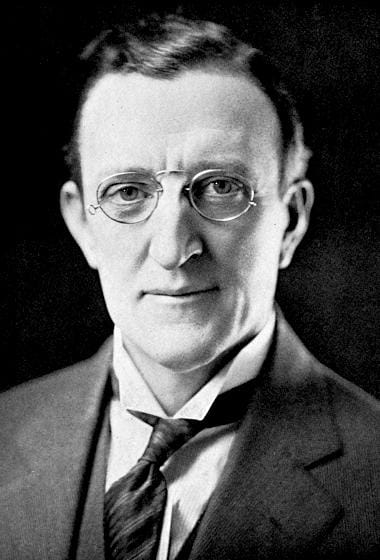
John Milton Price [1872-1948].
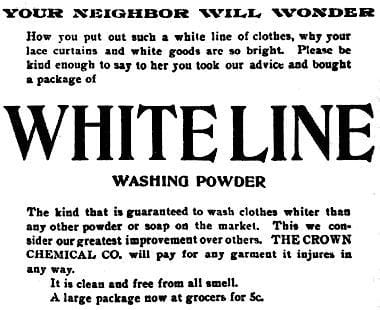
1901 White Live Washing Powder.
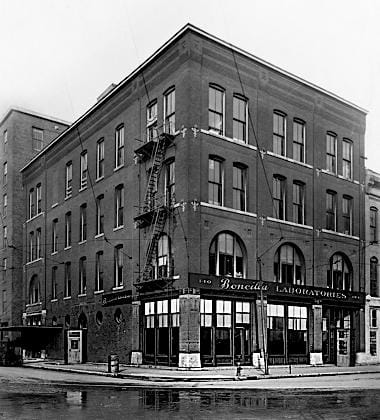
1921 The Boncilla Laboratories Building at 134-140 Pennsylvania Street, Indianapolis (Indiana Historical society). Constructed in 1889 for Holliday & Wyon, a harness, saddlery and leather business, it was remodelled in 1919 by Hurst & Co. which operated a department store there. They may have added the fire escape running down the outside of the building on Georgia Street.
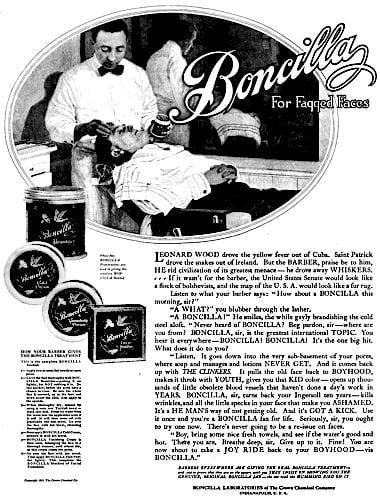
1921 Boncilla used in barber shops ‘for fagged faces’.
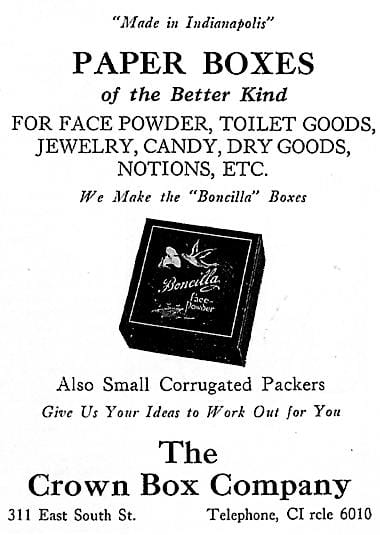
1922 The Crown Box Company.
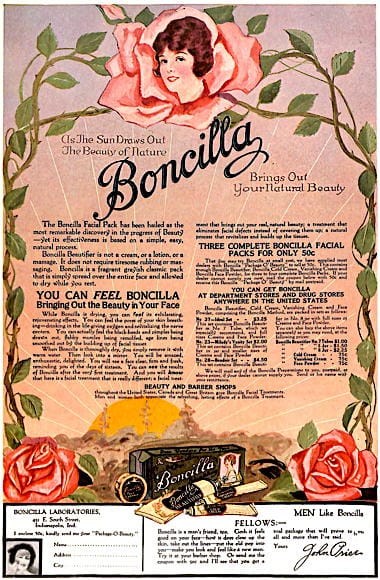
1922 Boncilla Laboratories.
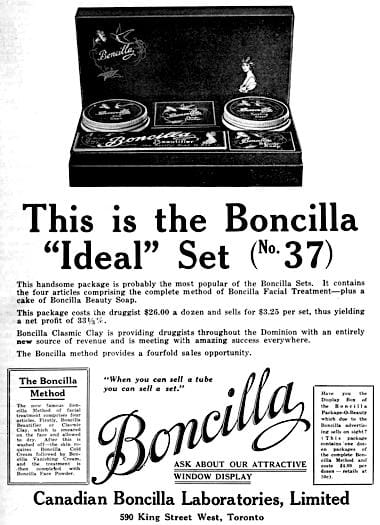
1923 Trade advertisment for Boncilla Ideal Set (Canada).
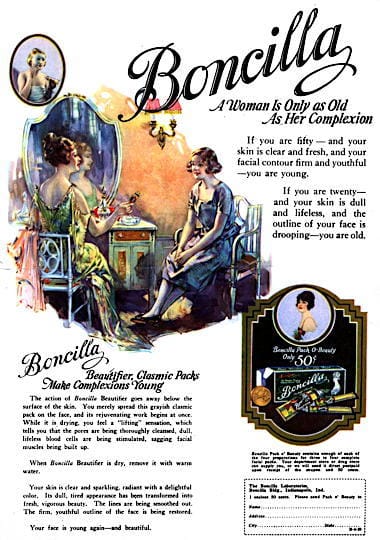
1923 Boncilla Clasmic Pack.
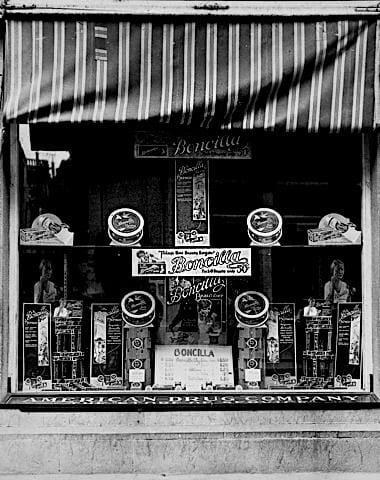
c.1924 Boncilla window display at the American Drug Company pharmacy, Nanking Road, Shanghai (University of Bristol).
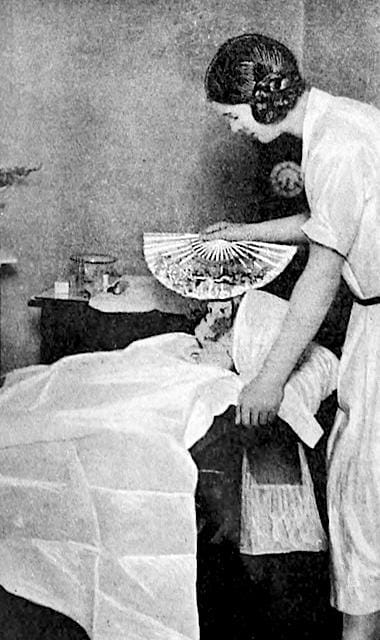
1925 Fanning the face during a Boncilla treatment at the Madame Bordier Salon in Richmond, England.
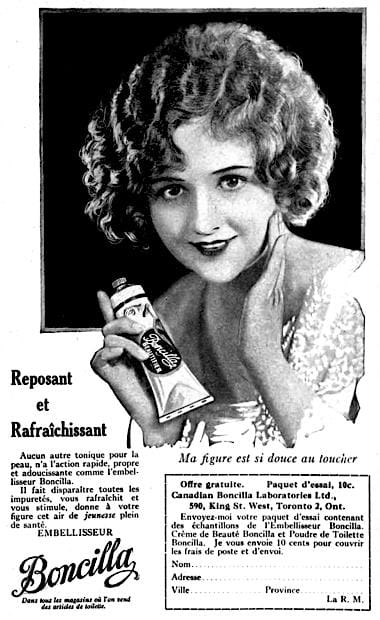
1925 Boncilla Beautifier (Canada).
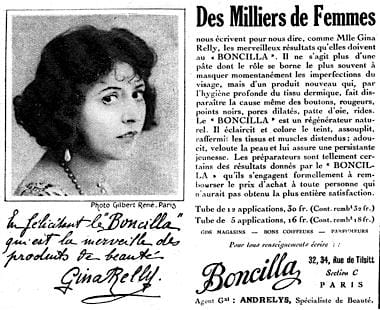
1925 Boncilla (France).
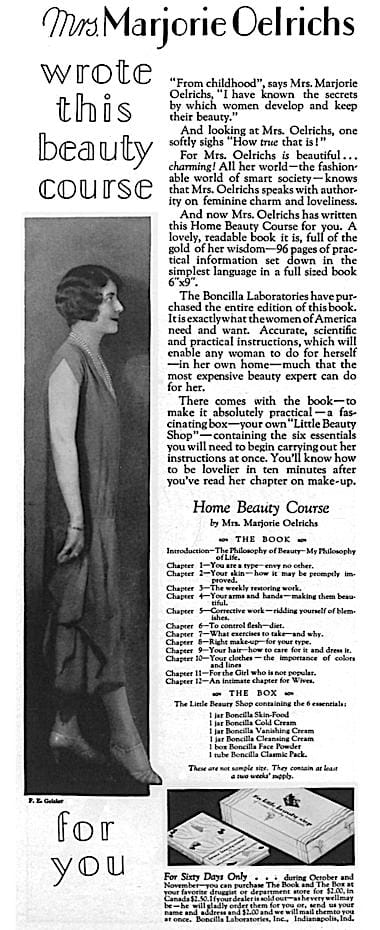
1927 Boncilla promotion combining a book by Mrs. Marjorie Oelrichs with a Boncilla Beauty Box.
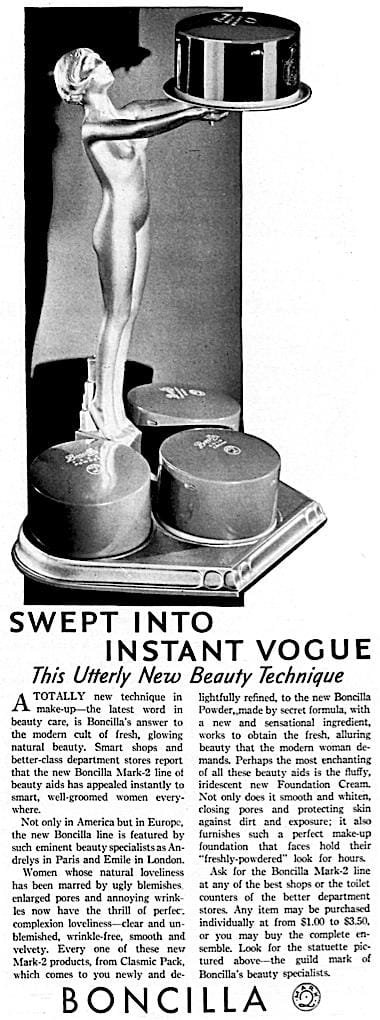
1930 Boncilla Mark 2.
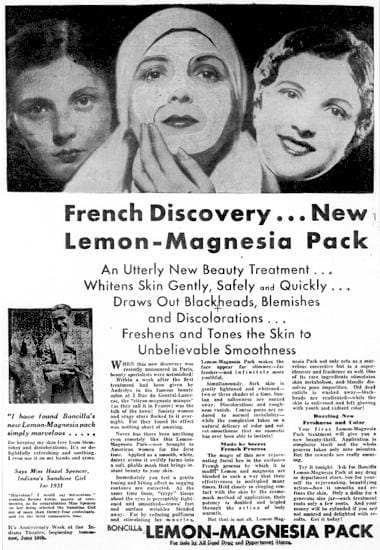
1931 Boncilla Lemon-Magnesia Pack.
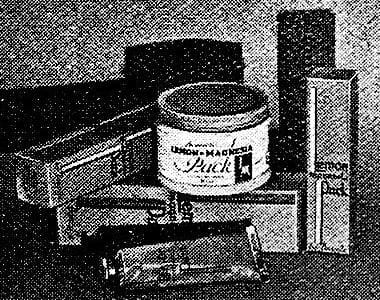
1931 Boncilla range in British packaging.
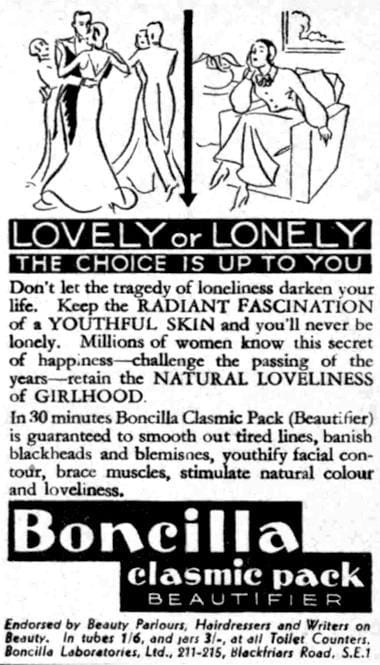
1935 Boncilla Clasmic Pack (UK).
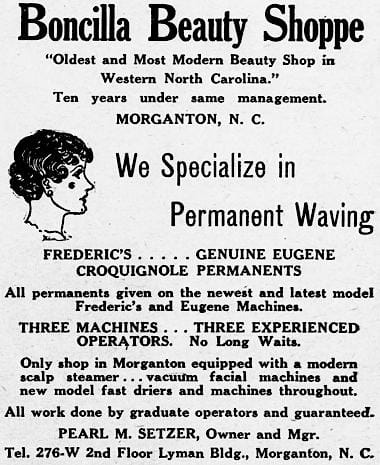
1935 Boncilla Beauty Shoppe. There were a number of Boncilla Beauty shops across the United States but they do not appear to have had any affiliation with Boncilla Laboratories.
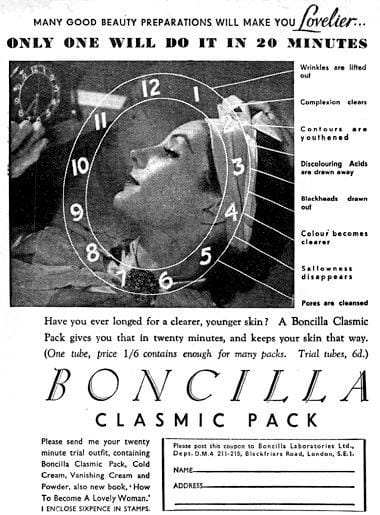
1937 Boncilla Clasmic Pack (UK).
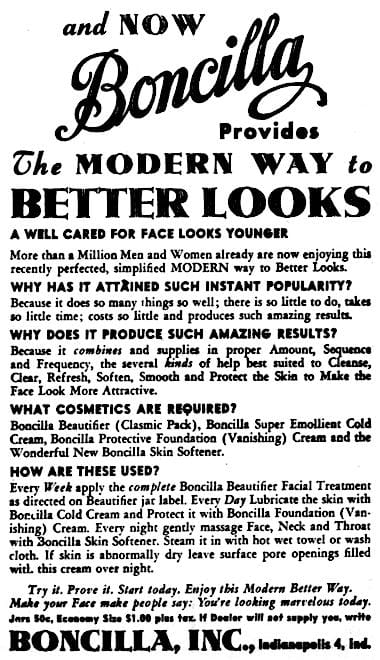
1947 Boncilla.
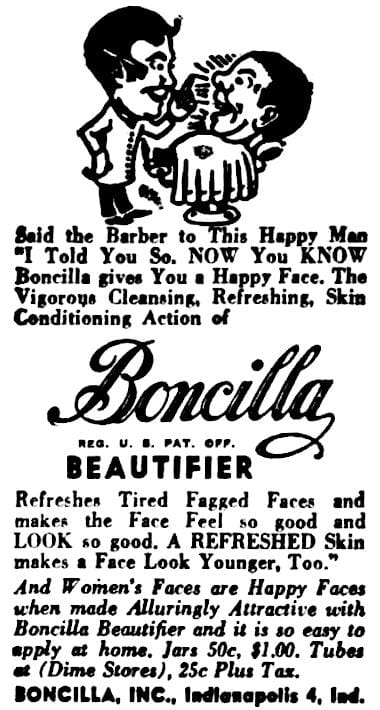
1948 Boncilla Beautifier, still recommended for men.
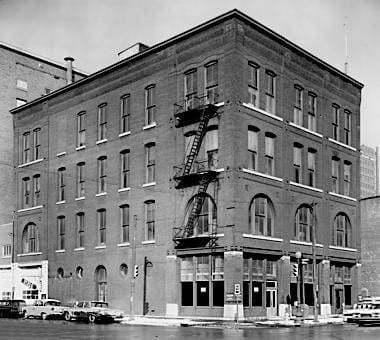
1961 The building at 134-140 Pennsylvania Street, Indianapolis no longer occupied by Boncilla.
